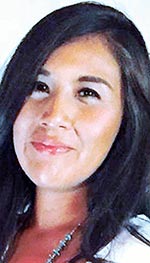
For Times’ youngest editor, persistence was key

Candace Begody-Begay

Candace Begody-Begay
One of the things I love most about my job is that we are in the business of creating something out of nothing. And I don’t mean that in the sense that we at the Navajo Times make up the news and publish aséez’.
Every single week, the reporters and photographers go out into the communities — open and receptive in their hearts and minds. They think about not only the issues the communities face, but also how to share it with our readers in a way that is interesting and captures their attention.
Last week, the Navajo Times launched its redesigned newspaper that will be the face of the newspaper for another decade or so. With that in mind, the reporters, photographers and I sat down sharing ideas about what articles and photos might be best for this very first edition.
In addition to ongoing issues on Navajo, a story on the front page titled, “Wool and grit: Siblings find healing after parents’ death,” featured two siblings who confronted and defied many odds.
If you recall, the story was about Carrie and Reno Tsosie, both of whom lost their mother and then soon after, buried their father after he committed suicide (both deaths are still under investigation). Before her mother passed, Carrie learned from her mother how to weave. She sold her rugs to raise her brother and put him through school. Reno eventually graduated from Stanford and now works in New York City. Carrie, also a graduate of Stanford, later completed her master’s from Harvard University and is working at San Juan College.
Carrie’s dream was to ensure that the most important person in her life received a quality education in high school and college despite the loss of their parents.
This was a perfect story because not only did it have many elements that make a good story — perseverance, loss and challenges, finding strength in Diné culture, and success — it was also timely as n’ha’alch’n’ are beginning their studies at their respective schools.
In the process, the right questions had to be asked and sometimes the same question has to be asked in five different ways, to get the most accurate and interesting responses.
Sometimes, it takes every strand of idea on the photographer’s head to be creative and make what might be an automatic dull subject into the subject of an award-winning photo. The photographer, like the reporter, sees things most of us don’t and there’s always a reason for the details in their pieces. There are subtle differences in some photos, for example, that really do mean the difference between a good photo and a great photo.
They are constantly working under pressure and constantly under a microscope by the public. With every single photo and story, they are constantly thinking about the Navajo readers. They work to the highest standards and expectations of journalism ethics including being honest and accurate, being fair and balanced, and most importantly, respecting the basic Navajo teachings and philosophies.
Yes, we are human and yes, we do make mistakes. But the way we think about our stories and photos are different than ever before.
When I was hired as the editor, there was one thing I wanted to change.
I wanted to get everyone thinking in a way that we hadn’t been thinking for a very long time about our news stories and photos.
I envisioned a staff immediately racing out the door the moment news broke, and then generating an article and quality photos to inform the public as expeditiously and accurately as possible.
I envisioned a team of journalists who didn’t care whether or not they were on the clock — which means they’re working 24 hours a day and 7 days a week – as long as they were passionate, they were going to get the job done.
I envisioned having an online presence because if someone like me could love news the way I do now and did at age 25, when I became the youngest to ever hold this post, I knew there were others out there that we needed to cater to.
Those are exactly the kind of reporters and photographers working for the Navajo Times. They are on the frontlines of holding our tribal officials accountable, but also giving a voice to the helpless, needy and voiceless.
Over the last few years, I’ve learned and grown in the job and in my personal life. Becoming a wife and mother has given me a broader perspective on life and made me a better writer and editor.
I hope I’ve paved the way for other young people who get their degrees and come back to the rez, only to have to prove themselves to a society that doesn’t quite trust them yet.
My staff and I hope you like the changes we’ve made to design, technology and content over the years, and we will continue to strive to bring you the best Diné Binaaltsoos that we can.
Most importantly, we appreciate the feedback from you, our readers – even when it’s negative.
Thank you for entrusting me with this important job, and please remember when a young person comes knocking on your door with a newly minted degree … Maybe all they need is a chance.
To read the full article, pick up your copy of the Navajo Times at your nearest newsstand Thursday mornings!
Are you a digital subscriber? Read the most recent three weeks of stories by logging in to your online account.








 Highway 264,
Highway 264, I-40, WB @ Winslow
I-40, WB @ Winslow